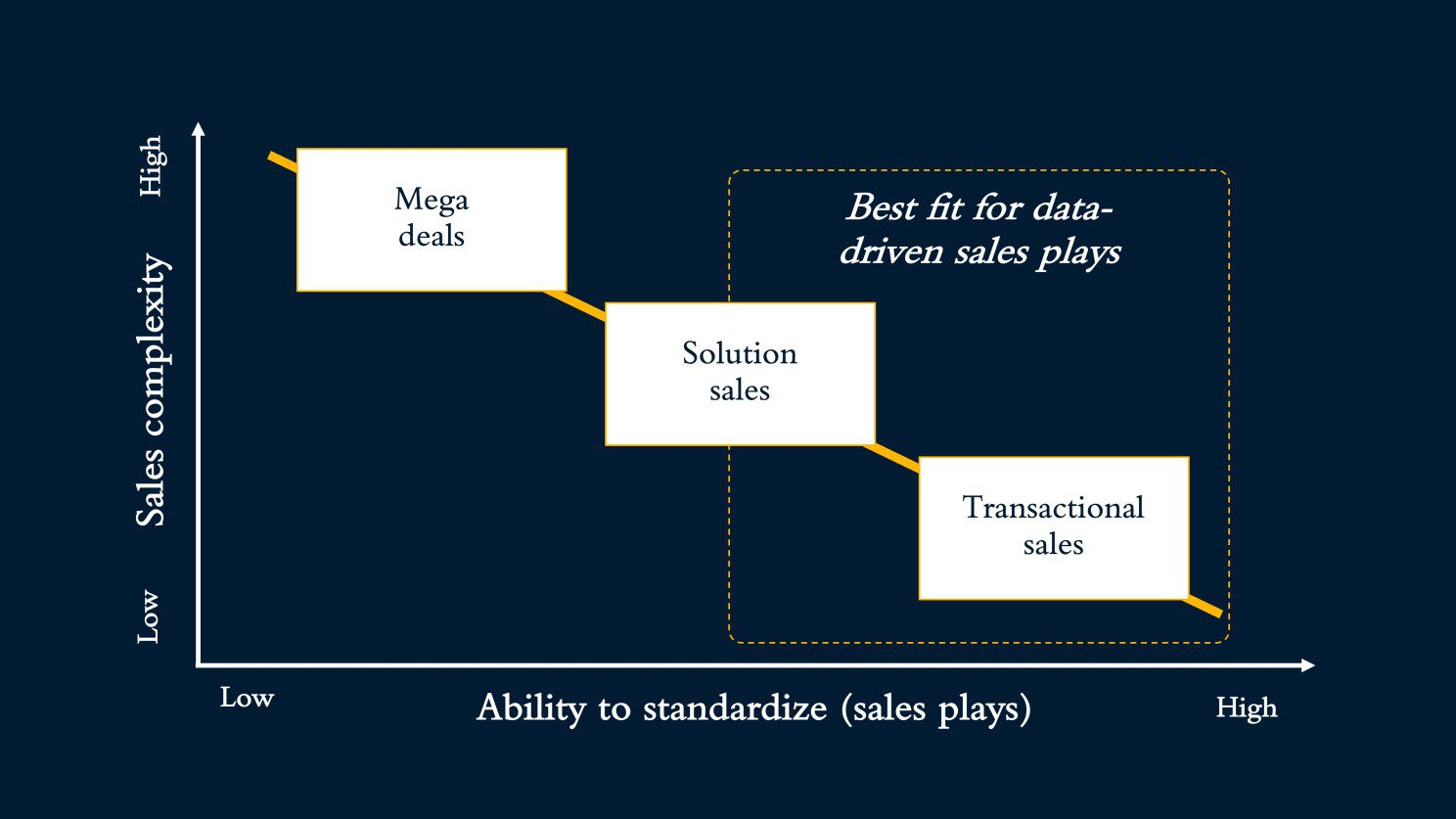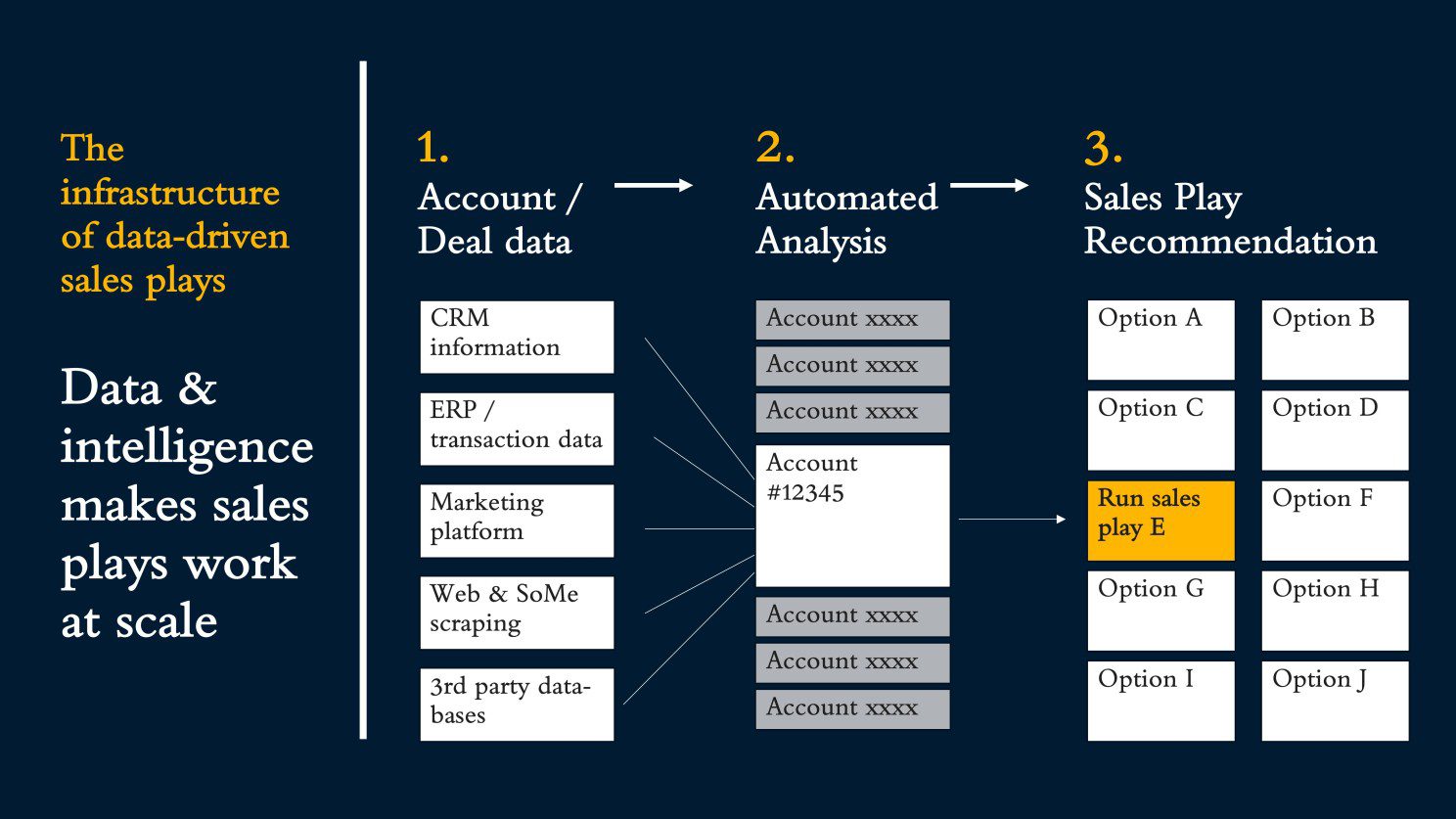While high performing B2B sales organisations are 2.7x more likely to use “Sales Plays” as an integrated part of the way they sell (Link), few sales leaders have yet moved beyond general sales methodology & high-level sales process, to guide their salespeople on how to succeed on a day-to-day basis.
- New product being launched as substitute for old solution: What’s the sales play to get existing buyers of old version to upgrade?
- New CMO hired at prospect account in target vertical: What’s the sales play to get the first value exploration meeting?
- Product portfolio gap identified at key account: What’s the sales play to position potential value for customer, to expand products being bought?
How we would like sales to sell in general and at a high level is clear (methodology & sales process), but how it’s actually done on a day-to-day basis remains a black-box for many (sales plays for specific situations), and specific guidance on how to succed remains sparse.
We give salespeople the theory and overall structure and ask them to “figure out”, how it should be translated into daily practices to win in concrete real life situations.

That was the exact situation for the sales organisation of a global €3bn turnover building materials manufacturer, who had recently reorganised into industry specific sales teams, but found itself facing long ramp up times, before its salespeople would have figured out what sales plays to run to succeed in the new selling environment.
To deal with the challenge, a small sales excellence team stepped in to help sales get up to speed faster and replace initial time consuming & ineffective guesswork with reliable guidance for sales on (a) who to spend time on, (b) what sales plays to run to succeed in those situations and (c) how to run those sales plays successfully
- Using data & intelligence to deliver automated recommendations to salespeople on who to spend time on and what to focus on in those interactions, delivered directly into CRM (e.g. account & transaction data indicates opportunity to cross sell product x)
- Having best-practice sales plays (step-by-step guidance on how to succeed) in place for each recommended focus area with supporting assets (e.g. call blueprint to get meeting booked, customer reference story to create interest before meeting, meeting material to support conversation, follow-up e-mail template etc.)
- Equipping sales with knowledge & skills required to run right sales plays, in the right situations in the right way (combination of e-learning, instructor led training, practical application & manager coaching)
The results, after having put the solution into operations in the first market (salespeople receiving data-driven recommendations in CRM and using set sales plays for different situations), were immediate and impressive: 90% of recommended sales plays to customers were found relevant by sales and 78% of them were successful in getting the customer to take desired action, intended by the sales play.
But, although research and the illustrative case above, shows high performing sales organisations being better at using sales plays as and integrate part of their way of selling, the fact remains that that the majority still don’t and begs the question:
If sales plays are so great – why are they still only being used by the few?
Sales plays are not for everyone
For sales organisations selling large complex highly tailored solutions to +10 person buying committees across a wide range of company types, the idea of a “typical situation” and “standard sales play”, likely does not make a lot of sense.
Because there are so many variables at play (customer characteristics, solution in scope, stakeholder landscape etc.), unique sales plays must be created for each unique situation, to succeed, by taking general sales methodology & process and applying it different situations.

On the other hand, if the salespeople of a sales organisation have more standardised offerings to sell to a more narrow group of buyers and target accounts (lower complexity sales), chances are that they will find themselves in similar situations over and over again, at both an individual and collective level.
It is also for sales organisations with lower sales complexity that typically has the most to gain from working with standardised sales plays for the most typical and critical situations, as this frees up more time for customer engagement and increases chances of success.
If you are in very high complexity sales, sales plays might not be for you. If you are not, it’s likely a great way to grow sales efficiency & effectiveness
Sales plays work best when backed by data & intelligence – And many B2B sales organisations are good at neither
The first step of sales play development is to understand what situations to develop sales plays for, which is a fairly straight forward task:
- Find out what specific situations salespeople in general find themselves in most often where they need to achieve a specific objective (through analysis of visit data in CRM, survey or salesforce interviews)
- Prioritise which of these are most critical to have best-practice sales plays in place for (scoring on potential impact on business results and difficulty to succeed with)
The problem is this only tells salespeople what the menu of sales plays looks like that they could run, but little about when to do so and towards which accounts
To avoid salespeople continuously spend large amounts of time gathering & analysing data to identify the right time and account to run a sales play towards, we automate the analysis and give the recommendation to sales when relevant, but that requires 2 things that many sales organisations often do not have in place:
- Sufficient data on accounts or deals to make qualified recommendations on best-fit sales plays to get most time invested
- Intelligent use of data to convert it into actionable insights for easy use by sales

Setting up sales to continuously run the right sales plays, towards the right accounts & people at the right times requires more than just have a menu of sales plays in place.
It requires building the infrastructure that enables the sales organisation for continuous play-making and improvements over time and that requires data + intelligence (algorithm to convert data into recommendations)
What starting to work with sales plays can do it, is make the potential value of getting data in place is and exactly what data would be needed to get sales play-making to work.
Lack of data & ability to use it intelligently is often a barrier to start working with sales plays, and often starting to work with sales plays is how you remove it.
Sales plays require being very concrete in guidance to sales on what to do – And few are comfortable doing that
Imagine being a sales professional at a company launching a new product, where you have just been invited to an on-boarding session by the product launch team, with the purpose of equipping you to take the new offering to market.
How would you prefer the product launch team equipped you to succeed?
- Give me all the knowledge they have about the product (features, value proposition, available material etc.) and I’ll figure out what to do
- Show me what I could do to get the new offering to market (which of my concrete accounts to target and what specific sales plays to run), and I’ll figure out what I need to know about the product to do so.
The problem most organisations face is that those who are planning the sales on-boarding or training typically have a different preference for how that question should be answered, compared to those who are on the receiving end.
Product launch team wants to share general knowledge about the product, and leave it to sales to figure out what then to do, but sales people with limited time to figure out how to do something new, wants to get some concrete guidance on what to do differently, when they come out of that session:
- Which concrete accounts in my portfolio are most ideal to book in meetings with, to get the product to market?
- How do I get meetings booked with the right stakeholders in these accounts? (e-mail templates, call blueprints, interest creating assets to share etc)
- How do I prepare myself -and prime the customer, to make the interaction successful? (meeting preparation sheet, meeting agenda template, customer reference story as primer etc.)
- How do I run the interaction, to get customer’s acceptance of the potential value of the new solution and committed to move forward in their buying process? (meeting blueprint & guidance questions/talking points, key visual material to share)
- How do I follow-up on the interaction, to move the buying process forward towards purchase of new solution? (follow-up e-mail template, product brochure etc.)

Few in the company are comfortable -or have the have the knowledge & skills required, to make recommendations to sales at this level of specificity and so most often they are left to figure it out on their own.
The key to overcoming this challenge is to get outside your comfort zone and involve high performing sales people in the organisation in the development of these sales plays, by testing different options for feedback & refinement, before more broad roll-out.
Lack of knowledge, skills and comfort in the organisation, to create & equip sales with winning sales plays is a typical barrier to start working with it. But likely one that can be overcome by bringing sales closer into the development process.
Start by developing one
Equipping the sales organisation with company specific sales plays has the potential to deliver all kinds of benefits:
- Higher sales efficiency, with less time needed for salespeople to create custom sales plays from scratch for each situation they find themselves in
- Higher sales effectiveness, with actions taken in a specific situation more likely to deliver desired result.
- Faster on-boarding of new hires, with step-by-step guidance on how to “play” the situations they will most often find themselves in.
- Lifts average salespeople to the level of high performers in the sales situations that matter the most, by running similar sales plays to succeed.
- Makes it easier for marketing to build the right sales enabling assets for front-line sales, because of higher clarity around what exact sales play they will be used for.
And although some of the barriers highlighted in the article above may be holding back more sales organisations from starting to make sales plays a fully integrated part of the way they sell, getting started is straight forward
You start by making 1 sales play and then expand the playbook from there
- Identify the #1 sales situation in your company to have a winning sales play for, and the (data) characteristics of this situation.
- Understand how what top-performers do in this situation and codify this into “step-by-step guidance (a sales play) for others
- Find or develop the right sales assets & tools to support sales play execution from start to end
- Prepare front-line sales training on how to identify when to run the specific sales play (what data characteristics need to be in place) and how to run the sales play like a top performer.



